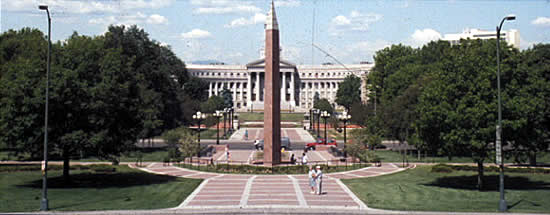

Guidelines for Preserving Cultural Landscapes
Spatial Organization + Land Patterns

Identify, Retain, and Preserve Historic Features and Materials
![]()
Identifying, retaining and preserving the existing spatial organization and land patterns of the landscape as they have evolved over time. Prior to beginning project work, documenting all features which define those relationships. This includes the size, configuration, proportion and relationship of component landscapes; the relationship of features to component landscapes; and the component landscapes themselves, such as a terrace garden, a farmyard, or forest-to-field patterns.
![]()
Undertaking project work without understanding the effect on existing spatial organization and land patterns. For example, constructing a new structure without researching a property’s agricultural and development history which may have created new spatial divisions.
Stabilize and Protect Deteriorated Historic Features and
Materials as a Preliminary Measure
![]()
Stabilizing deteriorated features that define spatial organization and land patterns, such as a deteriorating structure that separates a courtyard garden and a kitchen garden; a hedgerow along a farm’s perimeter which has an insect infestation; or a collapsing dry stone wall along a scenic parkway.
Protecting spatial organization and land patterns that extend beyond a landscape. Utilizing preservation tools such as acquisition, zoning, scenic and conservation easements.
![]()
Stabilizing deteriorated features that define spatial organization and land patterns, such as a deteriorating structure that separates a courtyard garden and a kitchen garden; a hedgerow along a farm’s perimeter which has an insect infestation; or a collapsing dry stone wall along a scenic parkway.
Protecting spatial organization and land patterns that extend beyond a landscape. Utilizing preservation tools such as acquisition, zoning, scenic and conservation easements.
Maintain Historic Features and Materials
![]()
Maintaining spatial organization and land patterns by non-destructive methods in daily, seasonal and cyclical tasks. For example, maintaining topography, vegetation and structures which define individual spaces or the overall pattern of the cultural landscape.
![]()
Failing to undertake preventive maintenance such as keeping volunteer tree and forest growth from spreading into open fields or meadows.
Utilizing maintenance methods which destroy or obscure the landscape’s spatial organization and land patterns.

When historic land uses cannot be continued, maintenance practices, such as mowing or prescribed burns, may be used to prevent the succession of old fields. This image depicts the results of such a cyclical maintenance action in Arkansas. (NPS, 1996)
Repair Historic Features and Materials
![]()
Repairing spatial organization and land patterns by use of non-destructive methods and materials when additional work is required. For example, repairing structures, reclaiming open space from woody plant intrusion, or replanting vegetation to recapture the individual spaces or overall patterns of the cultural landscape.
![]()
Failing to undertake necessary repairs or remedial action, resulting in the loss of spatial organization and land patterns.
Replacing a feature that defines spatial organization and land patterns when repair is possible.
Limited Replacement In Kind
of Extensively Deteriorated Portions
of Historic Features
![]()
Replacing in-kind deteriorating or missing parts of significant features that define spatial organization and land patterns. For example, replacing leaching tanks which define the interior spaces of a mining complex.
![]()
Failing to undertake the necessary in-kind replacements which may compromise the spatial organization and land patterns.
(top) The addition of this war memorial to the Civic Center in downtown Denver, Colorado, compromised the character-defining visual and spatial relationships of S. R. DeBoer’s 1924 design for the plaza. (NPS, 1993)
Early parkway designers faced the challenge of adapting traditional landscape architecture methods to the new speeds and scale demanded by automobiles. The identification and protection of historic planned views along the George Washington Memorial Parkway is an integral part of the parkway documentation project. (HABS, 1994)
